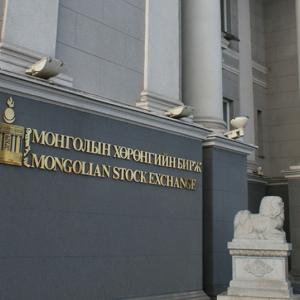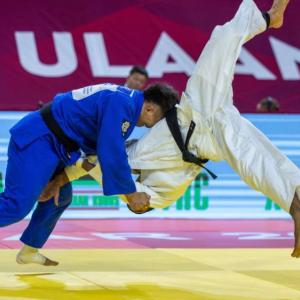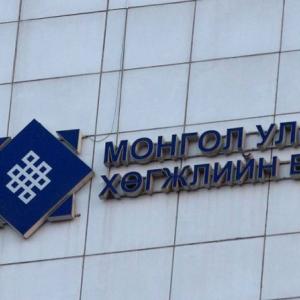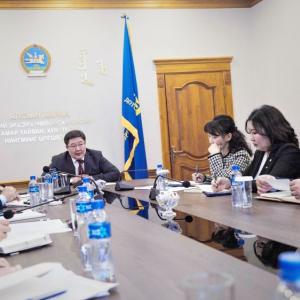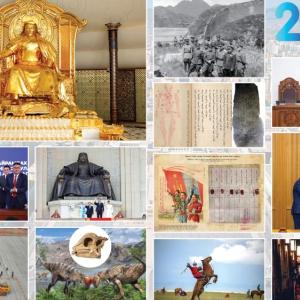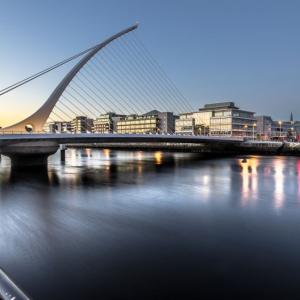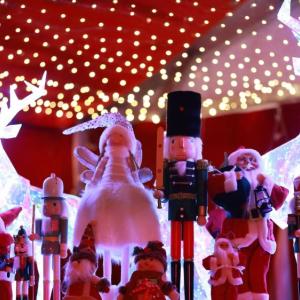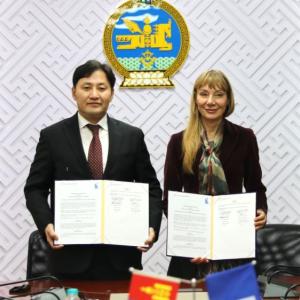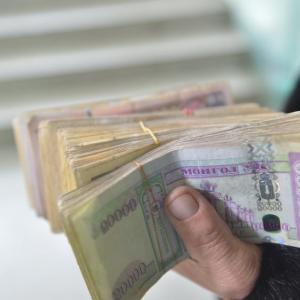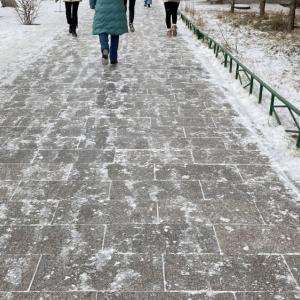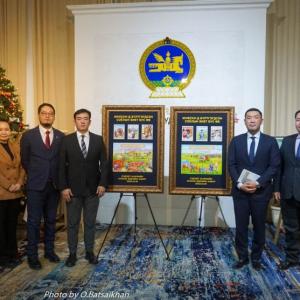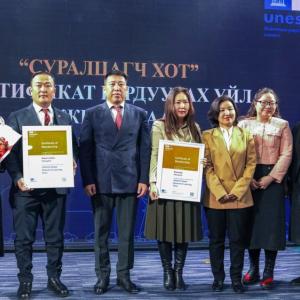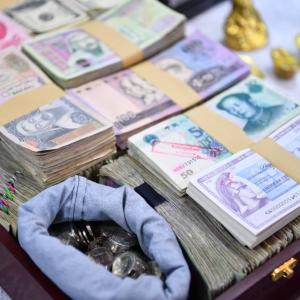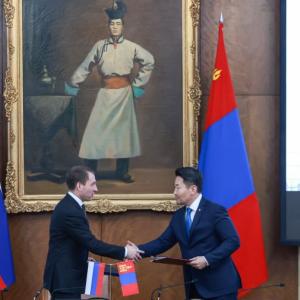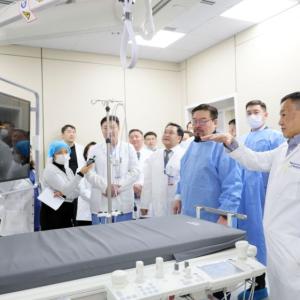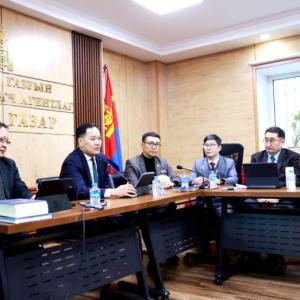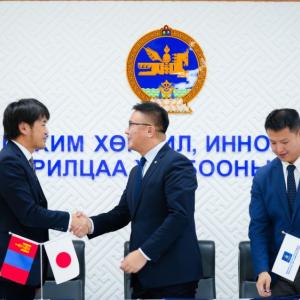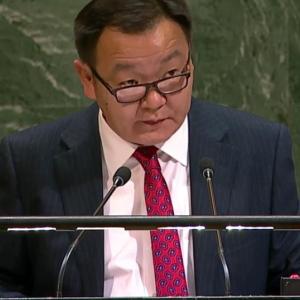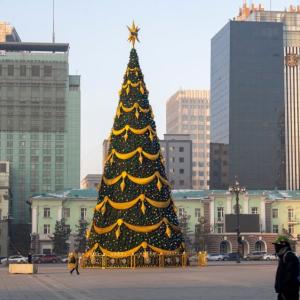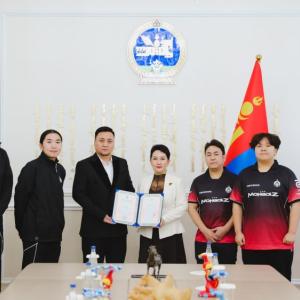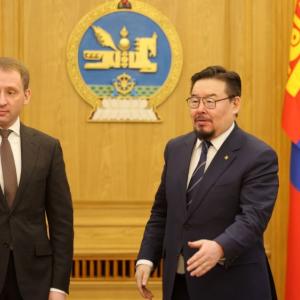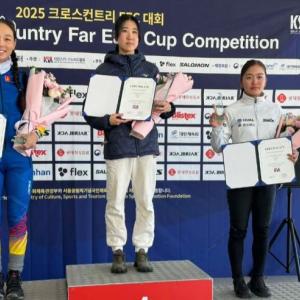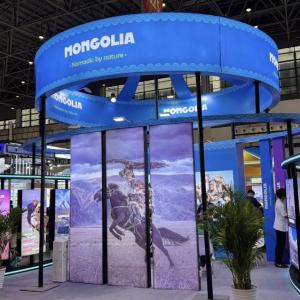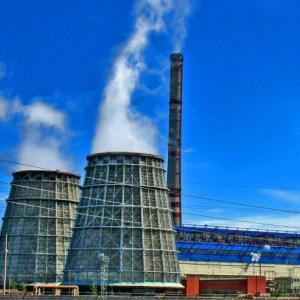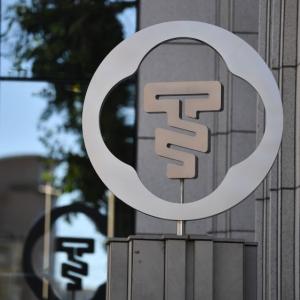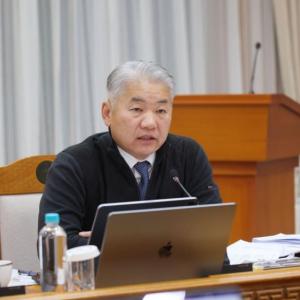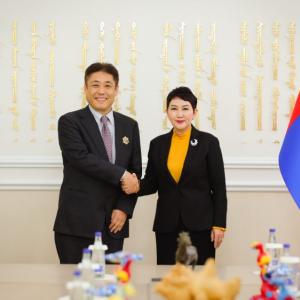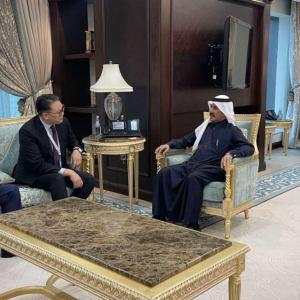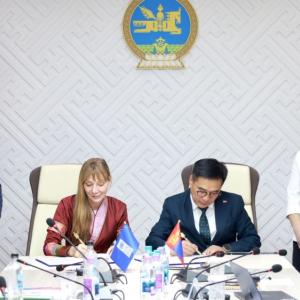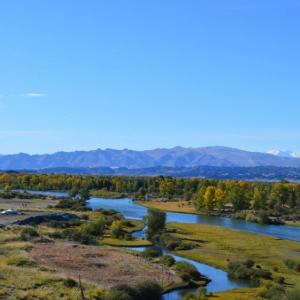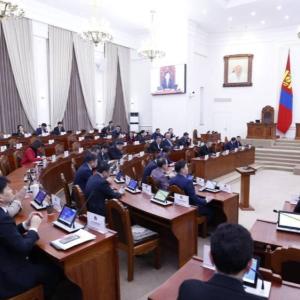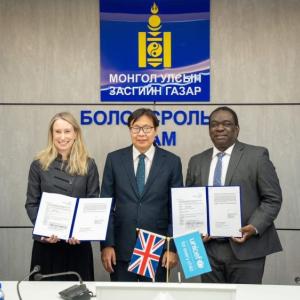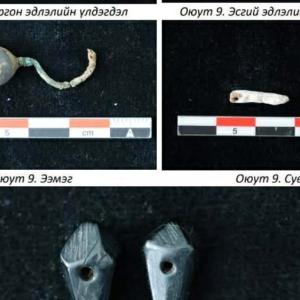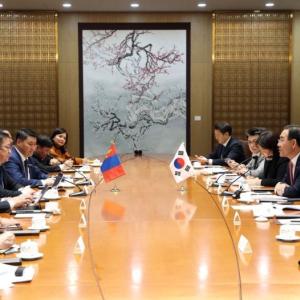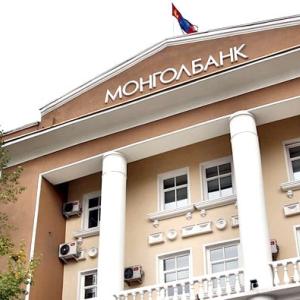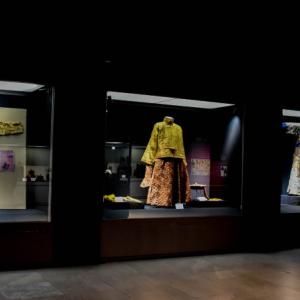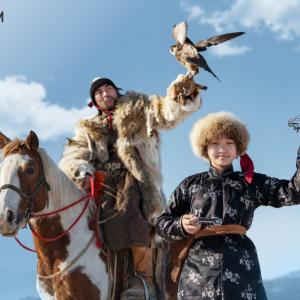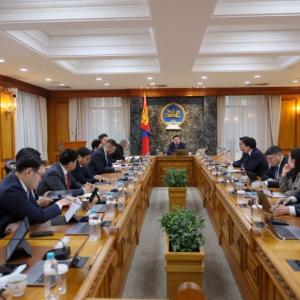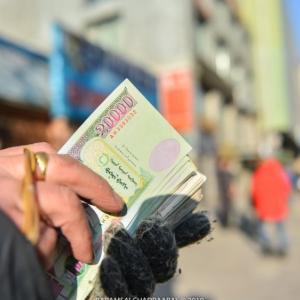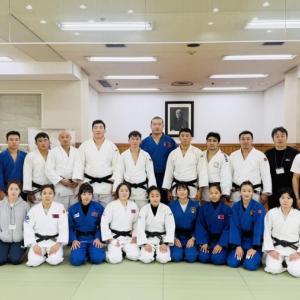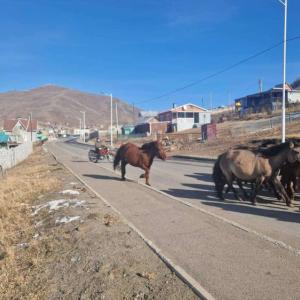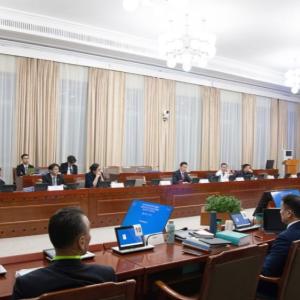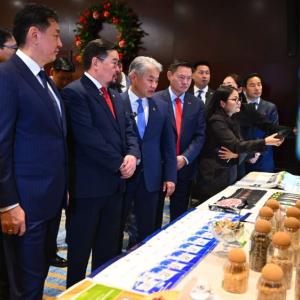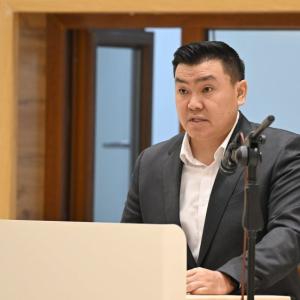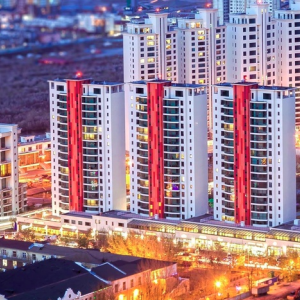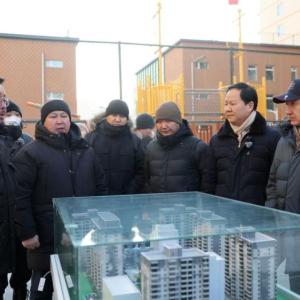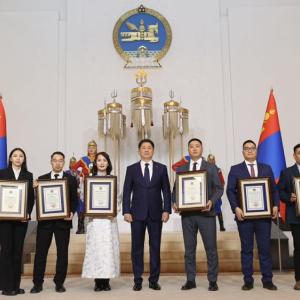Eternal creation combining the might of nature with the human mind
The Mongol MessengerReporters of the MONTSAME National News Agency visited ‘Aglag’ Meditation Temple of the Ulzii Badruulagch Monastery founded by Buddhist Artist G.Purevbat, Honored Artist of Mongolia in the beautiful valley of Daliin of the magnificent Garid Mountain in the territory of Bornuur Soum of Tuv Aimag.
The place captured our eyes with its perfect combination of national tradition, creativity and mastership of Buddhist artists with the peculiar landscape of terrain with rocks of various shapes and trees in the background of the picturesque natural environment. On the way to the Temple, visitors are met by different types of birds such as turkey, goose, fowl and others.

Buddhist artist G.Purevbat said that two days before the ceremony for laying the foundation of the monastery, he saw a dream where a huge rock was wrapped with khadags (Buddhist ceremonial scarf) which was worshipped by numerous believers. The very huge rock he saw in his dream emerged when the foundation was dug for the monastery. A 20-ton rock was left untouched as a symbol of the long-lasting existence of the complex.
When entering the temple, visitors’ attention is seized by three paintings that are created by G.Purevbat over the years. They feature teachers and Bogdo of their author. On its second floor, the Aglag Temple displays unique creatures that are deities of Mongolian mountains and rivers.
The valley is home to the golden turtle of Earthly Restraint, hairy fish, Samsara Ravine that are embodied in the rocks, mother’s womb, Gate of Life, Elephant rock, Ingot rock, Guru rock, Celestial Fist rock, Footprint rock, Wheel-branched Tree and Seat rock, Sliding rock and Farewell rock. Every pilgrim who enters the Gate Cave of Circumambulation should pray as he enters the gate to peace and enlightenment. The gate leads to a Bardo triangle-shaped passage that brings you to Bhaga and Phallus rocks symbolizing harmony from which visitors pray to obtain a rebirth in higher realms. The route goes around the monastery in a clockwise direction. The monastery is being built with donations of Mongolians only. A special temple is being erected for pilgrims as well.
 Terrific and majestic deities and mythical lives as a Tiger Dragon born from Dragon and Tiger, Eight-Limbed Lion born from Garuda and Lion, that are all created by Budhist Artist G.Purevbat inhabit here and guard the monastery from everything dark.
Terrific and majestic deities and mythical lives as a Tiger Dragon born from Dragon and Tiger, Eight-Limbed Lion born from Garuda and Lion, that are all created by Budhist Artist G.Purevbat inhabit here and guard the monastery from everything dark.
Rock table
At the time this place was chosen as the site for building the Meditation temple and the construction work hadn’t begun, Buddhist artist Purevbat had the same dream, repeatedly for three nights in a row, of a giant ‘gher’-shaped boulder with pilgrims circumambulating. Soon after, this huge rock was unearthed from beneath and was exalted inside the temple as it appeared upon a fortunate coincidence with his dream. This giant rock was accidentally split and shaped like a throne table was an auspicious omen in line with the story. Upon a decision of Shakyamuni Buddha to turn the first Wheel of Dharma in the forest of Rishi in Varanasi, there suddenly appeared one thousand jewel thrones of the Buddhas. He sat on the fourth throne in lotus posture and turned the first wheel of dharma for the sake of all sentient beings.
Stupa of Grain Heap with enshrined relics
The Stupa of Grain Heap enshrines 77 sacred relics of holy beings, such as Shakyamuni Buddha, Bodhisattvas, Sravakas and Yogacaras. This stupa was first created during the epoch of Light Protector (3rd Buddha) and is known as a Blessed worship, where Shakyamuni Buddha taught his tantric teaching. This stupa also enshrines 616 secret relics of Mongolian holy Lamas.
Conch Makara born from Makara and Conch
On the west side of the temple, there was a round boulder rock, which was engraved into a Conch Makara, one of three Victorious creatures of Harmony. Makara of the great Ocean mated with Conch and gave birth to the powerful creature named Conch Makara. Its upper body is of Makara and it has a lower body of conch. Wherever it is placed, there all chaos will be pacified.
Golden Temple
It’s a Golden octagonal temple with three-story roofs. The roofs will be gilt with gold leaf and the temple will be 13 meters in height constructed on the basement of 8 meters in height, totaling 21 meters high. This architecturally unique temple will enshrine the relics of Shakyamuni Buddha, 77 Bodhisattvas, Arhats and holy beings. Thus, it will be a singular temple of precious worship.
Tsatsa of over 600 high lamas’ relics
On April 10, 2003, the mass burial of over 600 lamas was found in the western gulch of Khanpo ovoo in Ulaanbaatar. The remains were purified, made into tsatsa (small offerings) and placed in the stupa built at the hill. Some of skulls and tsatsa offerings are kept in the Meditation temple where prayers for their good rebirth are performed.
Seven Lotus Petals
There are seven engraved lotus petals aligned towards the mother’s womb rock. This conforms to one of the Twelve Deeds of Shakyamuni Buddha’s Life-Birth in Lumbini: Upon his birth from the right ribs of his mother in Lumbini Garden with ten auspicious signs, Shakyamuni Buddha took seven steps in four directions to show the miraculous power of holy beings and the lotus flowers grew on the steps he took as offerings of the Earth Goddess.
Mother’s womb
On top of the rocky mountain in the eastern side of the temple, there is a rough and round rock boulder in the shape of mother’s womb facing to the sunrise direction. The monolith has a narrow tunnel underneath. Enter the narrow passage from the eastern side and come out from the western exit. The rock around the exit has the shape of a human butt as well as butthole. While entering this mother’s womb, generate your confession and repent to eradicate the obstructions and offer a prayer to find rebirth in higher realms.
‘Makara’ mouth
Nearby the sacred rock inscription of Avalokiteshvara mantra of ‘Om Ma Ni Pad Me Hum’ in Tibetan abridged script; there is the Makara-headed Rock (mythical sea-creature) with its mouth opened and teeth bared. Get into the mouth that fits a man inside, go throat and enter the stomach, where there’s the worship of ‘Liberator upon Seeing’. Pray, confess and repent your harmful acts. While going out through the back door, generate the mind to pursue the right path in this worldly life: not to commit any further harmful acts, to accumulate merit and not do harm to others. The mantra inscription of Avalokiteshvara demonstrates the significance of being a human who shall obtain a compassionate mind for others, practice Six Prajna Paramitas (the perfection of Transcendent Wisdom) and realize its benefit.
‘Celestial Fist’ rock
Just below the Lama Rock, there’s a giant fist-shaped monolith. Of interest is that this monolith is balanced on a small rock based beneath. Here you shall generate the mind to accumulate both mental and physical strength. In the south-east side the imagery of Shakyamuni Buddha practicing austerity on the bank of Nairanjana River (present-day Lilaja) is engraved on a giant rock with a flat base. This depiction demonstrates one of the W :-Twelve Deeds of Shakyamuni Buddha-Practicing Austerities and Asceticism for six years: On his spiritual quest, he led austerities on the bank of the Nairanjana River starting from the 8th of the last month of winter in 596 BC, by entering a complete state of Samadhi, meditative concentration.
Reclining Buddha in Parinirvana
Towards the end of circumambulation path, there is a stone statue 10 meters in length that represents a reclining Buddha in parinirvana reclining on his right side, facing west, with his head supported by his hand. In the forest of ‘Sala’ trees in Kushinagar, Shakyamuni Buddha taught ten benevolent deeds of passing into parinirvana to demonstrate the mortality of samsaric life, to generate the mind of renunciation and to obtain the Wisdom Truth Body. At the time when Shakyamuni Buddha manifested the passage into Parinirvana at the age of 80, a stupa was created and renowned as ‘Stupa of Parinirvana’. It demonstrates one of the Twelve Deeds of Shakyamuni Buddha’s life-the Passage into Parinirvana. The same Parinirvana Stupa was created north west of the Temple of Dharma Protectors located west of the main Meditation temple.
B.Oyundelger
The article with more photos is featured in the Mongolia Today magazine issue for January-March 2016.
 Ulaanbaatar
Ulaanbaatar






